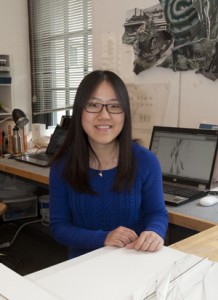
Chouteau’s Landing is one of St. Louis’ oldest neighborhoods, located on the Mississippi Riverfront, just south of the Gateway Arch. Before the Civil War, it was a busy commercial and residential hub. Today, it is largely blighted, cut off from downtown by a spaghetti tangle of bridges and interstates.
Yet the area retains certain advantages, says Tingting Wu, who will graduate May 18 with a master’s degree in architecture from the Sam Fox School of Design & Visual Arts.
In addition to river access — a surprisingly rare commodity in this famous “river city” — Chouteau’s Landing boasts a wealth of historic structures and a massive retaining wall bedecked with a decade’s worth of legally sanctioned graffiti art. More fundamentally, these depopulated streets, fronting the temperamental Mississippi, represent the intersection of two powerful forces: what Wu calls “natural wilderness” and “cultural wildness.”
“I was struck by the vines growing from the small cracks of the giant graffiti wall,” Wu says.
The image captured the way nature reasserts itself despite decades — and even centuries — of human intervention.
Yet Wu remained conflicted. “Is this something we’ve achieved, or is it something we lost?”
This spring, Wu sought to reconcile such questions with her thesis project, a large-scale redevelopment plan. Titled “Entropic Infrastructure,” it follows a series of recent civic efforts, notably the Confluence Greenway, a system of riverfront parks and recreation areas; and CityArchRiver 2015, which aims to improve connections between the Mississippi, the Arch grounds and downtown.
But Wu’s proposal is notable for its conceptual elegance and for amplifying, rather than bulldozing, ground conditions. For example, in a nod to the graffiti wall, she designed a series of triangular, folded concrete pavilions to house cafes, restaurants and other amenities. Exteriors would be draped in vegetation; interiors would be available to graffiti artists.
“The graffiti comes this way, and the natural landscape comes that way,” she says, interlacing her fingers for emphasis. “When they come together, it becomes the building and the project.
“From the Arch grounds, one sees the flow of cultural wildness,” she adds. Facing toward the Arch, “one sees the transition of natural wilderness to manicured landscape.”
Art and landscape: For Wu, it’s a fitting intersection, both thematically and personally.
Born and raised in Shanghai, China, Wu credits her father, Zhiren Wu, an accomplished amateur craftsman and student of Chinese literature, with instilling a love for the arts.
She drew and painted from an early age, developing a particular facility for landscapes.
As an undergraduate at Shanghai’s Fudan University, Wu studied biomedical engineering but missed the challenge and creativity of hands-on design. After graduation, she interned for a pair of Chinese architectural firms and then enrolled in the Sam Fox School’s Graduate School of Architecture & Urban Design.
“Architecture is unique because it can change how people think and live,” she says, but adds that the aesthetics of an individual structure are less important than its relationship with its surroundings.
“I don’t think architecture is an isolated practice. It is always connected to landscape or environment.”
“I have continuously admired Tingting’s work since she entered the program,” says Kathryn Dean, the JoAnne Stolaroff Cotsen Professor of Architecture and director of the graduate school.
“Tingting has an extraordinary sensitivity to the subtle nuances of both people and places. More importantly, she uses her gifted eye to reveal a new way of seeing the world.”
Following Commencement, Wu will move to New York City, though she hopes eventually to return to China.
“Architecture in China is very different from here,” Wu says.
In the Shanghai of her youth, “you saw buildings going up everywhere, every day, at a very quick pace,” she says.
All too often, that pace threatened to overwhelm local traditions and craftsmanship — just as blithe urban renewal once crippled neighborhoods like Chouteau’s Landing.
“China has a very long history and culture,” Wu says. “I think that architecture can work in a more thoughtful and responsible way.
“I want Chinese architecture to think about the future.”